Marble House, Athens, Greece, Sunday evening, 25 March 2001
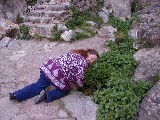

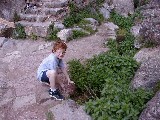 Saturday morning, in brilliant weather, we went to the archaeological site of Delphi. It is magnificently situated in a concavity in the south side of Mount Parnassus, a setting often likened to a huge natural amphitheater. At my suggestion we stopped first at the Castalian spring to cleanse ourselves in its waters, as the ancient pilgrims did before consulting the Delphic Oracle. As none of our party carried the blood-guilt of murder, we just swabbed our hair and hands and faces, not our whole bodies.
Saturday morning, in brilliant weather, we went to the archaeological site of Delphi. It is magnificently situated in a concavity in the south side of Mount Parnassus, a setting often likened to a huge natural amphitheater. At my suggestion we stopped first at the Castalian spring to cleanse ourselves in its waters, as the ancient pilgrims did before consulting the Delphic Oracle. As none of our party carried the blood-guilt of murder, we just swabbed our hair and hands and faces, not our whole bodies.
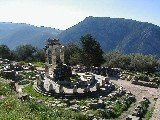
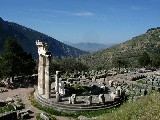
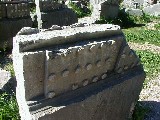 Being already so far east, we elected next to visit the lower part of the site, downhill from the road, containing the magnificent but mysterious tholos (round temple) in the Doric style. Like so much of what is finest from ancient Greece, it dates from the fifth century B.C. At right, a fallen block shows the characteristic guttae of the Doric style, imitation wooden pegs carved in marble. Much of the Doric style likewise retains features of its origins in wooden buildings, including the column flutings, originally characteristic of tree-trunks shaped with convex adzes, and the triglyphs, shaped like the Roman numeral III and representing wooden beam-ends.
Being already so far east, we elected next to visit the lower part of the site, downhill from the road, containing the magnificent but mysterious tholos (round temple) in the Doric style. Like so much of what is finest from ancient Greece, it dates from the fifth century B.C. At right, a fallen block shows the characteristic guttae of the Doric style, imitation wooden pegs carved in marble. Much of the Doric style likewise retains features of its origins in wooden buildings, including the column flutings, originally characteristic of tree-trunks shaped with convex adzes, and the triglyphs, shaped like the Roman numeral III and representing wooden beam-ends.
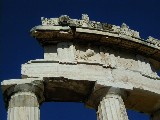
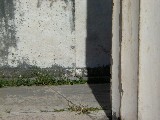
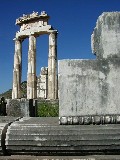 Here are detailed views of its top, with scultured metopes, including one of a rearing horse, alternating with the triglyphs; and of its bottom. In the foreground of the rightmost photo in this group you can see some of the beautifully carved marble of the treasury of Massalia, a sixth-century-B.C. building in the Aeolian style (a slight variant on Ionic, with palm-leaf capitals).
Here are detailed views of its top, with scultured metopes, including one of a rearing horse, alternating with the triglyphs; and of its bottom. In the foreground of the rightmost photo in this group you can see some of the beautifully carved marble of the treasury of Massalia, a sixth-century-B.C. building in the Aeolian style (a slight variant on Ionic, with palm-leaf capitals).

 On the way back to the main site--the sanctuary precinct or Temenos of Apollo--we could look down and back at the gymnasium stoa, over the tops of road-side olive trees unaccountably still in fruit (left). We stopped at a refreshment place, discreetly recessed beneath the sidewalk on the downhill side of the road, where there was fresh-squeezed orange juice; the photo at right looks up past their wysteria trellis and through the branches of some plane trees on the sidwalk above.
On the way back to the main site--the sanctuary precinct or Temenos of Apollo--we could look down and back at the gymnasium stoa, over the tops of road-side olive trees unaccountably still in fruit (left). We stopped at a refreshment place, discreetly recessed beneath the sidewalk on the downhill side of the road, where there was fresh-squeezed orange juice; the photo at right looks up past their wysteria trellis and through the branches of some plane trees on the sidwalk above.
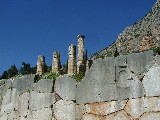

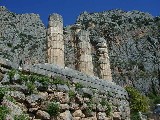 These next six photos all show the temple of Apollo, the heart of the site. (The Treasury of the Athenians, the most fully reconstructed of the buildings on the site, was unfortunately too deep in scaffolding to be photogenic.) The temple built by the exiled Alcmaeonids of Athens late in the six century B.C., and cited with admiration by poets and philosophers of the classical period, lasted only one hundred forty years before collapsing in an earthquake in 373 B.C.; this one was built to replace it.
These next six photos all show the temple of Apollo, the heart of the site. (The Treasury of the Athenians, the most fully reconstructed of the buildings on the site, was unfortunately too deep in scaffolding to be photogenic.) The temple built by the exiled Alcmaeonids of Athens late in the six century B.C., and cited with admiration by poets and philosophers of the classical period, lasted only one hundred forty years before collapsing in an earthquake in 373 B.C.; this one was built to replace it.
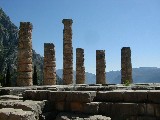
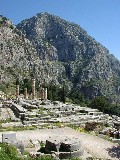
 Some say it was in the bowels of this temple that both the "navel-stone" marking earth's center and the oracular shrine and chasm were located. The opening scene of the Eumenides of Aeschylus suggests they were contiguous.
Some say it was in the bowels of this temple that both the "navel-stone" marking earth's center and the oracular shrine and chasm were located. The opening scene of the Eumenides of Aeschylus suggests they were contiguous.
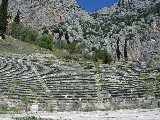
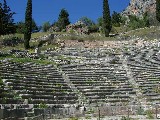
 Just above the temple of Apollo is a fine and well-preserved fourth-century-B.C. theater.
Just above the temple of Apollo is a fine and well-preserved fourth-century-B.C. theater.
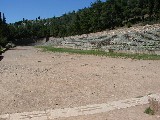
 Still higher up the slope is the stadium where the athletic events of the Pythian Games were held.
Still higher up the slope is the stadium where the athletic events of the Pythian Games were held.
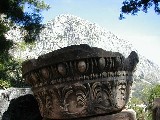
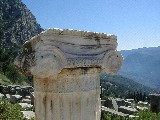 The site is notable for the extraordinarily high quality even of the odds and ends scattered about, including this font and this Ionic capital with spondyl. The former is just outside the museum exit, amid other pieces that the more careless visitors think nothing of sitting on.
The site is notable for the extraordinarily high quality even of the odds and ends scattered about, including this font and this Ionic capital with spondyl. The former is just outside the museum exit, amid other pieces that the more careless visitors think nothing of sitting on.
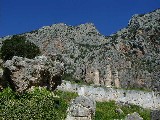

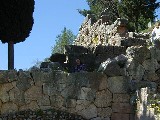 There is also a great variety of wall-masonry styles well exemplified here. At left, with the "Sybil's Rock" in left foreground (from which the first Delphic prophetess, Herophile, supposedly predicted the Trojan War), and again in the center photo of the Stoa of the Athenians, you can see a curved-polygonal style unique to Delphi, in a wall built to help support the Alcmaeonid temple. In the photo at right you can see both Lesbian polygonal and ashlar (rectangular-block) styles, in front of and behind Stas respectively.
There is also a great variety of wall-masonry styles well exemplified here. At left, with the "Sybil's Rock" in left foreground (from which the first Delphic prophetess, Herophile, supposedly predicted the Trojan War), and again in the center photo of the Stoa of the Athenians, you can see a curved-polygonal style unique to Delphi, in a wall built to help support the Alcmaeonid temple. In the photo at right you can see both Lesbian polygonal and ashlar (rectangular-block) styles, in front of and behind Stas respectively.
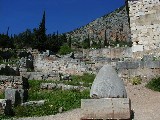
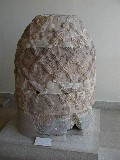 The photo at left shows a modern navel-stone apparently put out for the tourists: touch it and make a wish, and have your picture taken in the process. On the right, from inside the museum, is an ancient copy of the real one, carved to represent woollen bands on the surface.
The photo at left shows a modern navel-stone apparently put out for the tourists: touch it and make a wish, and have your picture taken in the process. On the right, from inside the museum, is an ancient copy of the real one, carved to represent woollen bands on the surface.
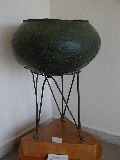
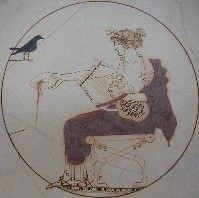 The museum also contains a remarkably well-preserved (though much repaired) tripod and cauldron, from the seventh century B.C., the whole assembly about four and a half feet tall. This is the sort of thing often cited by Homer as treasure goods for princely gifts or offerings to the gods. The exquisite painting of Apollo, the eternal ephebe (adolescent), with his lyre, pouring a libation of wine, is from a small kylix--a saucer-shaped pottery vessel with base and handles--from the fifth century B.C.
The museum also contains a remarkably well-preserved (though much repaired) tripod and cauldron, from the seventh century B.C., the whole assembly about four and a half feet tall. This is the sort of thing often cited by Homer as treasure goods for princely gifts or offerings to the gods. The exquisite painting of Apollo, the eternal ephebe (adolescent), with his lyre, pouring a libation of wine, is from a small kylix--a saucer-shaped pottery vessel with base and handles--from the fifth century B.C.
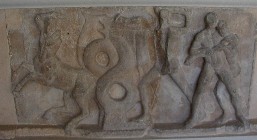
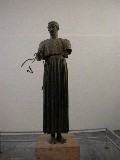 This scene of Heracles and the Hydra comes from the proskênion of the theater. Much finer work is the famous bronze charioteer, life size, from a fifth-century-B.C. monument commemorating a Syracusan victory in the Pythian games.
This scene of Heracles and the Hydra comes from the proskênion of the theater. Much finer work is the famous bronze charioteer, life size, from a fifth-century-B.C. monument commemorating a Syracusan victory in the Pythian games.
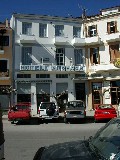
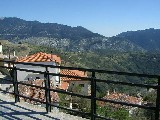 We stopped for lunch just up the road from Delphi at Aráhova, where Stas and I had paid a memorable visit on our 1987 bicycle trip through Greece, staying at this little hotel and locking our bikes to this fence opposite. We caught the wonderful local panayía or festival of St. George at Aráhova on that earlier trip, which began with our arrival here in Athens exactly fourteen years ago this very evening. This time we finally got around to sampling the local specialty cheese, formaella, which is served grilled with lemon juice and salt and pepper, and is rather bland and curiously textured so that it squeaks against the teeth.
We stopped for lunch just up the road from Delphi at Aráhova, where Stas and I had paid a memorable visit on our 1987 bicycle trip through Greece, staying at this little hotel and locking our bikes to this fence opposite. We caught the wonderful local panayía or festival of St. George at Aráhova on that earlier trip, which began with our arrival here in Athens exactly fourteen years ago this very evening. This time we finally got around to sampling the local specialty cheese, formaella, which is served grilled with lemon juice and salt and pepper, and is rather bland and curiously textured so that it squeaks against the teeth.
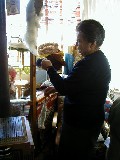 We also did a little souvenir shopping, and in the process saw a demonstration of spinning using the same sort of spindle that Plato uses as a model for the cosmos in the Republic.
We also did a little souvenir shopping, and in the process saw a demonstration of spinning using the same sort of spindle that Plato uses as a model for the cosmos in the Republic.
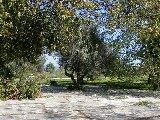 Afterwards we bypassed Thebes, and soon gave up on an attempt to find lodgings in Chalcis (Halkída), another spot of fond memory from the bicycle trip. Instead we pushed on towards our next featured stop, Marathon, which we had to overshoot slightly before getting rooms for the night. In the morning we went back to try to see the burial mound for the remarkably few Athenians who died in the battle, but the site was fenced and closed for Sunday, Independence Day, or both, and this was as close as I could get.
Afterwards we bypassed Thebes, and soon gave up on an attempt to find lodgings in Chalcis (Halkída), another spot of fond memory from the bicycle trip. Instead we pushed on towards our next featured stop, Marathon, which we had to overshoot slightly before getting rooms for the night. In the morning we went back to try to see the burial mound for the remarkably few Athenians who died in the battle, but the site was fenced and closed for Sunday, Independence Day, or both, and this was as close as I could get.
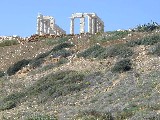
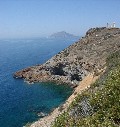 The same problem faced us at Sounion later that same day around noon, but at least there the temple ruins are clearly and impressively visible from the distance to which one is kept when the site is closed, and the weather was finer than for our previous visit.
The same problem faced us at Sounion later that same day around noon, but at least there the temple ruins are clearly and impressively visible from the distance to which one is kept when the site is closed, and the weather was finer than for our previous visit.

 The weather showed the seawater below to better advantage, and the extra personnel, specifically Elizabeth, made it possible for my own face to put in a rare appearance on these pages, together here with Stas's.
The weather showed the seawater below to better advantage, and the extra personnel, specifically Elizabeth, made it possible for my own face to put in a rare appearance on these pages, together here with Stas's.


 Many though not all of the flowers were different this time.
Many though not all of the flowers were different this time.
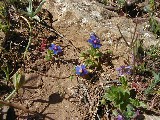
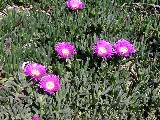

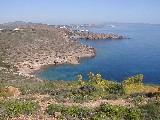 These views look to the northwest (left) and northeast (right) of the headland of Sounion, which is the southernmost point in Attica.
These views look to the northwest (left) and northeast (right) of the headland of Sounion, which is the southernmost point in Attica.
 We made a beach stop for the children at Anávissos on the way north from Sounion into Athens.
We made a beach stop for the children at Anávissos on the way north from Sounion into Athens.
previous entry
next entry
main/ToC page


 Being already so far east, we elected next to visit the lower part of the site, downhill from the road, containing the magnificent but mysterious tholos (round temple) in the Doric style. Like so much of what is finest from ancient Greece, it dates from the fifth century B.C. At right, a fallen block shows the characteristic guttae of the Doric style, imitation wooden pegs carved in marble. Much of the Doric style likewise retains features of its origins in wooden buildings, including the column flutings, originally characteristic of tree-trunks shaped with convex adzes, and the triglyphs, shaped like the Roman numeral III and representing wooden beam-ends.
Being already so far east, we elected next to visit the lower part of the site, downhill from the road, containing the magnificent but mysterious tholos (round temple) in the Doric style. Like so much of what is finest from ancient Greece, it dates from the fifth century B.C. At right, a fallen block shows the characteristic guttae of the Doric style, imitation wooden pegs carved in marble. Much of the Doric style likewise retains features of its origins in wooden buildings, including the column flutings, originally characteristic of tree-trunks shaped with convex adzes, and the triglyphs, shaped like the Roman numeral III and representing wooden beam-ends.


 Saturday morning, in brilliant weather, we went to the archaeological site of Delphi. It is magnificently situated in a concavity in the south side of Mount Parnassus, a setting often likened to a huge natural amphitheater. At my suggestion we stopped first at the Castalian spring to cleanse ourselves in its waters, as the ancient pilgrims did before consulting the Delphic Oracle. As none of our party carried the blood-guilt of murder, we just swabbed our hair and hands and faces, not our whole bodies.
Saturday morning, in brilliant weather, we went to the archaeological site of Delphi. It is magnificently situated in a concavity in the south side of Mount Parnassus, a setting often likened to a huge natural amphitheater. At my suggestion we stopped first at the Castalian spring to cleanse ourselves in its waters, as the ancient pilgrims did before consulting the Delphic Oracle. As none of our party carried the blood-guilt of murder, we just swabbed our hair and hands and faces, not our whole bodies.










































